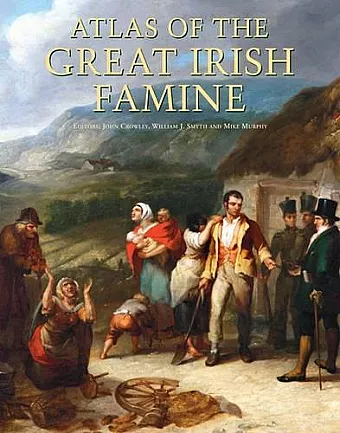Atlas of the Great Irish Famine
Mike Murphy editor William J Smyth editor John Crowley editor
Format:Hardback
Publisher:Cork University Press
Published:1st Jul '12
Should be back in stock very soon

The Great Famine is possibly the most pivotal event/experience in modern Irish history. Its global reach and implications cannot be underestimated. In terms of mortality, it is now widely accepted that over a million people perished between the years 1845-1852 and at least one million and a quarter fled the country, the great majority to North America, some to Australia and a significant minority ((0.3 million) to British cities. Ireland had been afflicted by famine before the events of the 1840s; however the Great Famine is marked by both its absolute scale and its longevity. It is also better remembered because it was the most recent and best documented famine. This atlas comprising over fifty individual chapters and case studies will provide readers with a broad range of perspectives and relevant insights into this tragic event. The atlas begins by acknowledging the impossibility of adequately representing the Great Famine or any major world famine. Yet by exploring a number of themes from a reconstruction of pre-Famine Ireland onwards to an exploration of present-day modes of remembering; by the use of over 150 highly original computer generated parish maps of population decline, social transformation and other key themes between the census years 1841 and 1851: and through the use of poetry, contemporary paintings and accounts, illustrations and modern photography, what this atlas seeks to a achieve is a greater understanding of the event and its impact and legacy. This atlas seeks to try and bear witness to the thousands and thousands of people who died and are buried in mass Famine pits or in fields and ditches, with little or nothing to remind us of their going. The centrality of the Famine workhouse as a place of destitution is also examined in depth. Likewise the atlas seeks to represent and understand the conditions and experiences of the many thousands who emigrated from Ireland in those desperate years. Included are case studies of famine emigrants in cities such as Liverpool, Glasgow, New York and Toronto. A central concern of the atlas is to seek to understand why a famine of this scale should occur in a nineteenth-century European country, albeit a country which was subject to imperial rule. In addition, it seeks to reveal in detail the...
Cork University Press has established an enviably high reputation in producing atlases. The latest - of the Great Irish Famine - maintains and enhances this record. Not only are the maps themselves innovative and attractive to look at, but they communicate clearly an abundance of information, often unfamiliar. The cartography is accompanied by a wealth of other images, sometimes strikingly beautiful, and also hauntingly distressful. In addition, a starry cast of experts provides incisive and illuminating commentary on all aspects of the disaster. All in all, this is likely to prove one of the most original and enduring studies of the grievous famine. Toby Barnard, History, Oxford University This monumental work is far more than an Atlas, it is the definitive summary of all aspects of the Great Irish Famine. The many maps are accompanied by accessible yet scientifically sound texts. The demographics and geography are surveyed with unequaled detail and care, yet the historical background, the politics, and the economics of the Famine are discussed at an equally high scholarly level. Lavishly illustrated and scholarly immaculate, written by the best scholars in the field, this volume belongs in the library of everyone interested in the greatest natural disaster of the modern age - Joel Mokyr, Robert H. Strotz Professor of Arts and Sciences, Department of Economics, Northwestern University, USA This Atlas offers a powerful, unflinching and coherent understanding of the Irish Famine as the defining event in Irish history. It balances sweeping survey with minute details, while always attending to the surprising diversity of this small island in the mid nineteenth century. Its unparalleled assemblage of new maps, old images and extensive documentation offers a brilliant teaching aid for the history of Ireland and of the Irish diaspora. Firmly rooted in recent research, saturated in meticulous scholarship, and interdisciplinary in the best sense, it is unafraid to draw the necessary trenchant conclusions. Its broad synthesis offers the best overview we have ever had of this traumatic and defining episode-Professor Kevin Whelan, Keough Naughton Notre Dame Centre, Dublin.
- Winner of Best Irish Published Book of the Year 2012
ISBN: 9781859184790
Dimensions: unknown
Weight: unknown
728 pages